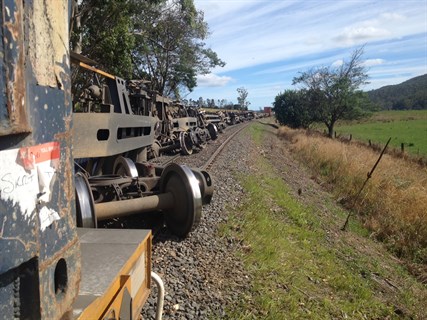Safety summary
What happened
A limited-scope, fact-gathering investigation into this occurrence was conducted in order to produce this short summary report and allow for greater industry awareness of potential safety issues and possible safety actions.
On 25 January 2015, TasRail train 135 was travelling the Western Line between Railton and Deloraine (Tasmania). The train consisted of two locomotives TR01 & TR14 hauling 28 wagons. The trailing load was about 1254 tonnes and total train length (including locomotives) was about 460 m.
At about 2151, train 135 derailed near Kimberly (about 30 km south of Devonport) as it traversed an occupation crossing[1] at the(kilometre point) KP W99. As a result, 10 wagons derailed and 220 m of track was damaged. There were no injuries.
Train 135 and derailed wagons
Source: TasRail
What was found
Track geometry
The track between the KP W92 and KP W100 had been subject to various speed restrictions since 2008. In June 2014, a temporary speed restriction (TSR) was put in place due to poor track condition - reducing track speed from 30 km/h to 20 km/h. An increased track inspection frequency had been implemented with track patrols monitoring defect deterioration at 96 hour intervals.
Post-derailment track measurement identified a number of track geometry defects in the vicinity of the occupation crossing. The defects consisted of a sequence of (vertical) track twists and horizontal misalignments.
The track defects exceeded the limits specified in the TasRail Track and Structure Maintenance Standard (INF-TS-211 dated 1 March 2014), and were being managed through the application of a temporary speed restriction in accordance with an Infrastructure Waiver (018, dated 5 November 2014).
Rolling stock
The first wagon to derail was a QL class wagon. The QL class was a flat container wagon (originally a standard gauge RENY class wagon) converted for use on the TasRail narrow gauge rail network. The wagons were about 15.2 m in length with a deck height of about 1110 mm.
Wagon QLE23/P (the first wagon to derail) was loaded with two, twenty-foot equivalent (TEU) standard shipping containers. Each container was loaded with general goods, with a gross mass of 18.5 t and 22.4 t respectively. The load within each container was stacked uniformly to almost roof height. While the load generally conformed to the requirements of the TasRail Freight Loading Manual, calculations indicated that the load most likely exceeded the maximum centre of gravity limit of 1700 mm (above rail). All other components and parameters of wagon QLE23/P were within maintenance limits.
Conclusion
It was concluded that the sequence of track defects (twist and alignment) initiated harmonic body roll of the QL class wagon. When combined with the high centre of gravity of loaded wagon QLE23/P, the harmonic behaviour likely resulted in wheel unloading, promoting flange climb and the subsequent derailment of train 135.
Safety action
As a result of this occurrence, the TasRail has advised the ATSB that they are taking the following action in order to reduce their safety risk:
- Suspension of QL wagons from intermodal traffic pending outcome of investigation.
- Maintain a register of known track faults.
- Measure major track faults every 96 hour inspection of the infrastructure, for track deterioration.
- Review current condition monitoring methods and frequencies, and implement changes to detect and manage similar defects to those observed at the derailment location.
- Re-write / update Section B of the Freight Loading Manual regarding container loading restrictions and what wagons are applicable.
- Reduce the TSR speed where legacy wagons are in use and rail faults dictate.
- Check / update the Tasrail Operational Risk Register.
ATSB comment
The ATSB has, in the past, investigated derailments with similar contributing factors. On 22 May 2007, ballast train 3MR2 derailed near Roopena, SA (ATSB investigation RO-2007-003). In that instance, the investigation determined that a combination of track geometry and rolling stock factors combined to cause the derailment. The investigation also found that uneven load distribution had contributed.
While a number of actions have been taken to address the safety issues, the ATSB concluded that there were further opportunities for improvement, such as:
- Consideration of the combined effects of track geometry defects when assessing a track speed suitable for safe rail operations.
- Consideration of the characteristics of poorer-riding rolling stock when assessing track geometry defects for the application of temporary speed restrictions.
Safety message
In light of previous similar occurrences, this incident further highlights to operators and maintainers, the importance of considering the combined effects of adjacent or localised track geometry irregularities when assessing appropriate temporary speed restrictions. The incidents also highlight the importance of considering freight loading (centre of gravity and load distribution) and the dynamics of poorer-riding rolling stock, when assessing track geometry defects and determining a suitable speed limit for train operations.
Purpose of safety investigationsThe objective of a safety investigation is to enhance transport safety. This is done through:
It is not a function of the ATSB to apportion blame or provide a means for determining liability. At the same time, an investigation report must include factual material of sufficient weight to support the analysis and findings. At all times the ATSB endeavours to balance the use of material that could imply adverse comment with the need to properly explain what happened, and why, in a fair and unbiased manner. The ATSB does not investigate for the purpose of taking administrative, regulatory or criminal action. TerminologyAn explanation of terminology used in ATSB investigation reports is available here. This includes terms such as occurrence, contributing factor, other factor that increased risk, and safety issue. Publishing informationReleased in accordance with section 25 of the Transport Safety Investigation Act 2003 Published by: Australian Transport Safety Bureau © Commonwealth of Australia 2015
Ownership of intellectual property rights in this publication Unless otherwise noted, copyright (and any other intellectual property rights, if any) in this report publication is owned by the Commonwealth of Australia. Creative Commons licence With the exception of the Coat of Arms, ATSB logo, and photos and graphics in which a third party holds copyright, this publication is licensed under a Creative Commons Attribution 3.0 Australia licence. Creative Commons Attribution 3.0 Australia Licence is a standard form licence agreement that allows you to copy, distribute, transmit and adapt this publication provided that you attribute the work. The ATSB’s preference is that you attribute this publication (and any material sourced from it) using the following wording: Source: Australian Transport Safety Bureau Copyright in material obtained from other agencies, private individuals or organisations, belongs to those agencies, individuals or organisations. Where you wish to use their material, you will need to contact them directly. |
[1] Level crossing provided for a private roadway.


